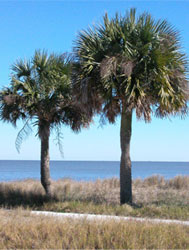Florida State Tree - Sabal Palmetto

This tree got its name as cabbage palmetto, owing to its frontal part which appears like the top of a cabbage. The tree can grow up to a height of 20 meters, and width of the trunk comes around 60 cm in diameter. The leaves come out bare petiole and they give out a fan like appearance. The leaves can grow up to a length of 80 cm.
The trees produce flowers which bloom with a blend of whitish yellow coloration. They are produced in large multiple panicles, and thus these flowers extend beyond the leaves.
The fruits produced by the trees are black drupe fruits, the length of the fruit is around 1 cm, and they possess a single seed. The specialty of the fruits is that they are extremely salt tolerant and they can thrive well in tremendous frosty conditions. It can also survive short periods of temperatures, even when the temperature is as low as -14 °C.
In mid-summer the cabbage palm put up with creamy white flowers on a
long branched inflorescence that is held completely within the crown.
Soon after the flowers whither away, the black spherical drupe fruit occupies
its place and this happens around late fall or early winter, and these
fruits are about one third of an inch in diameter. Inside is a shiny brown
seed that is about one quarter of an inch in diameter. Cabbage palm is
most of the time visited by Squirrels, raccoon and many other species
of mammal.
The tree also provides a kind of food for the Native American living in
those regions, the terminal bud of tree, which is considered to be the
growing heart of the leaves, is extracted for food. But then unfortunately
soon after this bud is extracted the tree would tend to die, because the
bud is very important for its survival.
The tree would easily adapt itself to most types of soils, thus it proves
to be excellent for beach side plantations, and this tree can also be
used for ornamental purpose. The government of Florida has planted these
trees abundantly along the road side, as they provide a soothing and cool
effect to the onlooker and they can also absorb the noise pollution in
the roads.












 Florida Symbols
Florida Symbols